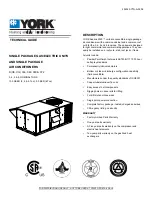
7 Installation
Installer reference guide
34
EBLQ+EDLQ011~0W1 + EK(2)CB07CAV3
Daikin Altherma low temperature monobloc
4P538847-1 – 2018.05
WARNING
Due to presence of glycol, corrosion of the system is
possible. Uninhibited glycol will turn acidic under the
influence of oxygen. This process is accelerated by the
presence of copper and high temperatures. The acidic
uninhibited glycol attacks metal surfaces and forms
galvanic corrosion cells that cause severe damage to the
system. Therefore it is important that:
▪ the water treatment is correctly executed by a qualified
water specialist,
▪ a glycol with corrosion inhibitors is selected to
counteract acids formed by the oxidation of glycols,
▪ no automotive glycol is used because their corrosion
inhibitors have a limited lifetime and contain silicates
which can foul or plug the system,
▪ galvanized pipes are NOT used in glycol systems since
the presence may lead to the precipitation of certain
components in the glycol's corrosion inhibitor.
Adding glycol to the water circuit reduces the maximum allowed
water volume of the system. For more information, refer to the
chapter "To check the water volume and flow rate" in the installer
reference guide.
7.6.5
To fill the water circuit
1
Connect the water supply hose to the drain and fill valve.
2
Open the drain and fill valve.
3
If an automatic air purge valve was installed, make sure it is
open.
4
Fill the circuit with water until the manometer (field supply)
indicates a pressure of ±2.0 bar.
5
Purge as much air as possible from the water circuit. For
instructions, see
"9 Commissioning" on page 67
.
6
Refill the circuit until the pressure is ±2.0 bar.
7
Repeat steps 5 and 6 until no more air is purged and there are
no more pressure drops.
8
Close the drain and fill valve.
9
Disconnect the water supply hose from the drain and fill valve.
NOTICE
The water pressure indicated on the manometer will vary
depending on the water temperature (higher pressure at
higher water temperature).
However, at all times water pressure shall remain above
1 bar to avoid air entering the circuit.
7.6.6
To fill the domestic hot water tank
For installation instructions, see the installation manual of the
domestic hot water tank.
7.6.7
To insulate the water piping
The piping in the complete water circuit MUST be insulated to
prevent condensation during cooling operation and reduction of the
heating and cooling capacity.
To prevent the freezing of the outdoor water piping during winter
time, the thickness of the sealing material MUST be at least 13 mm
(with λ=0.039 W/mK).
If the temperature is higher than 30°C and the humidity is higher
than RH 80%, the thickness of the insulation materials should be at
least 20 mm to prevent condensation on the surface of the
insulation.
During winter, protect the water piping and shut‑off valves against
freezing by adding heat tape (field supply). If the outdoor
temperature can drop below –20°C and no heat tape is used, it is
recommended to install the shut‑off valves indoors.
7.7
Connecting the electrical wiring
7.7.1
About connecting the electrical wiring
Before connecting the electrical wiring
Make sure the water piping is connected.
Typical workflow
Connecting the electrical wiring typically consists of the following
stages:
1
Making sure the power supply system complies with the
electrical specifications of the units.
2
Connecting the electrical wiring to the outdoor unit (if
applicable).
3
Connecting the electrical wiring to control box EKCB07CAV3 (if
applicable).
4
Connecting the electrical wiring to option box EK2CB07CAV3 (if
applicable).
5
Connecting the main power supply
6
Connecting the backup heater power supply
7
Connecting the user interface.
8
Connecting the shut–off valves (if applicable).
9
Connecting the electrical meters (if applicable).
10
Connecting the domestic hot water pump (if applicable).
11
Connecting the alarm output (if applicable).
12
Connecting the space cooling/heating ON/OFF output (if
applicable).
13
Connecting the changeover to an external heat source (if
applicable).
7.7.2
Precautions when connecting the
electrical wiring
INFORMATION
Also read the precautions and requirements in the
following chapters:
▪ General safety precautions
▪ Preparation
DANGER: RISK OF ELECTROCUTION
WARNING
ALWAYS use multicore cable for power supply cables.















































